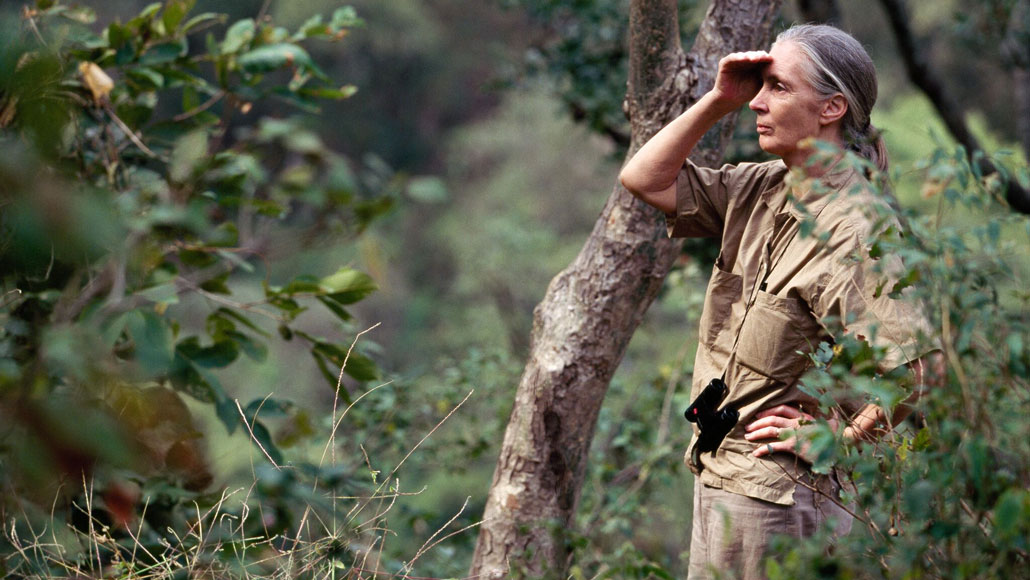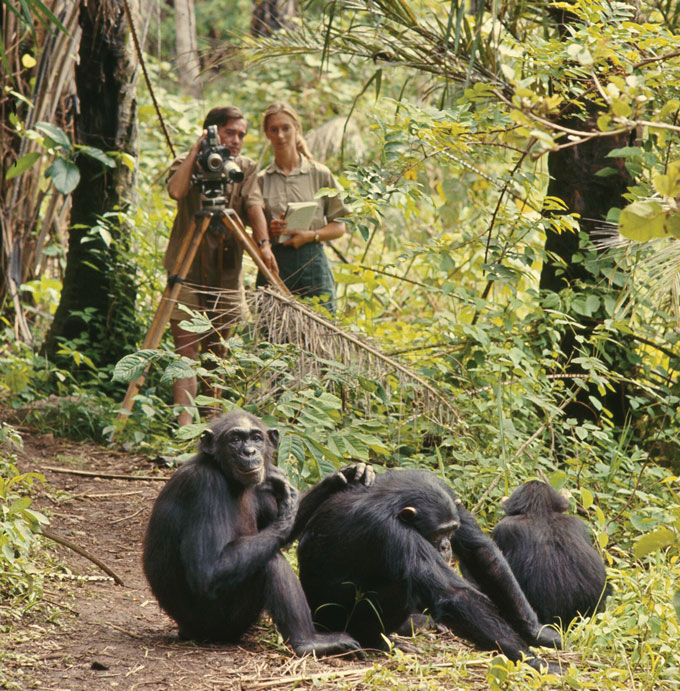A new exhibit invites you to step into Jane Goodall’s life
“Becoming Jane” celebrates the work of the famed chimpanzee researcher

Jane Goodall, shown 35 years after beginning her chimpanzee research, is the subject of a new exhibit organized by National Geographic and the Jane Goodall Institute.
Michael Nichols/National Geographic
Jane Goodall began observing chimpanzees in 1960, but her first study of animal behavior took place some 20 years earlier, when she was about 5 years old. One afternoon, she disappeared from home for several hours. Just as her panicked mother was about to contact the police, young Jane returned. “Well, I’ve been in a henhouse, waiting to see how a hen laid an egg,” she explained. “Nobody’d tell me, so I just sat down. And now I know.”
That curiosity helped propel Goodall to become one of the most famous scientists of the 20th century. Her evolution from precocious child to “global icon” is documented in “Becoming Jane,” an exhibit at the National Geographic Museum in Washington, D.C., through September 7. After that, the exhibit heads to the Natural History Museum of Los Angeles County.
For an exhibit devoted to a researcher whose equipment was as simple as a pen and paper, “Becoming Jane” is technology heavy. Interactive digital displays, 3-D experiences and a hologram-like appearance by Goodall herself will capture the attention of both adults and youngsters. For those who have followed Goodall’s career closely, the real treat is seeing her childhood mementos, field notes, Ph.D. thesis and other personal belongings and photos.

Goodall’s early possessions tell a story of someone who seemed destined to study chimpanzees. On her first birthday, her father gave her a stuffed animal, a chimp. The toy is in the exhibit, its fur nearly all worn away, perhaps from too many hugs. Goodall’s favorite books included Tarzan of the Apes and The Story of Doctor Dolittle. On a page from a nature magazine Goodall made with her friends, visitors can see neatly drawn hands of different creatures, including chimps, with details on what “purpose” each kind of hand has.
As the exhibit segues to Goodall’s adulthood, visitors learn that her childhood dream of going to Africa came true in 1957, when a friend who had moved to Kenya invited Goodall for a visit. While there, she met the famed paleoanthropologist Louis Leakey and became his secretary. Leakey was looking for someone to study wild chimps. At the time, most of what science knew about the apes came from captivity, the exhibit explains.
Leakey thought observing chimps’ natural behaviors would provide insight into the lives of early human ancestors. He wanted a female researcher because he thought women were more patient and observant than men. The exhibit lets Leakey speak for himself, through a video as well as a letter he wrote to the National Geographic Society in search of funding.
Goodall accepted Leakey’s challenge, despite having no formal training, and on July 14, 1960, she arrived at the Gombe Stream Game Reserve in what is today Tanzania. Almost 60 years later, Gombe is home to the world’s longest-running study of wild chimps. A life-size replica of Goodall’s tent helps visitors experience what life was like during the early days. The work required patience. For the first few months, the chimps ran away when Goodall would approach. But then one day, two chimps stayed, and others eventually followed suit.

That pivotal moment is re-created in an immersive 3-D film (anyone prone to motion sickness should skip it) that precedes the most fun part of the exhibit: what Goodall learned about chimps. Visitors can mimic various types of chimp calls or try on a pair of augmented reality binoculars that reveal CGI chimps using tools. Goodall, in fact, was the first scientist to see wild chimpanzees use and make tools (SN: 3/21/64, p. 191) — including plant stems for fishing termites out of a mound. Until then, tool use was thought to be a uniquely human endeavor. Some real chimp tools are on display. Another of Goodall’s revolutionary observations was that chimps hunt and eat meat, a fact recorded in her field notes. The exhibit brings some of Goodall’s notes and drawings to life in animations projected above real documents.
In 1986, Goodall took up environmental activism full time, motivated by how endangered chimpanzees are. Today, just 340,000 remain in the wild, compared with the 1 million to 2 million thought to have lived a century ago. Several text-heavy panels describe the main threats chimpanzees face today, including habitat loss, disease and trafficking. It’s a bit overwhelming to follow the intertwining factors that contribute to these problems. Featuring a few of Goodall’s conservation success stories more prominently — and concretely — would have been helpful.
“Becoming Jane” ends on a note of hope. Human ingenuity, young people and the power of social media are among the things that keep Goodall, who celebrated her 85th birthday last year, optimistic about the planet’s future. The exhibit ends with a digital “Tree of Hope,” where visitors can make Earth-friendly pledges, such as avoiding single-use plastics.
At a time when the environmental challenges facing the world can feel insurmountable, Goodall reminds us that individuals can make a difference.







